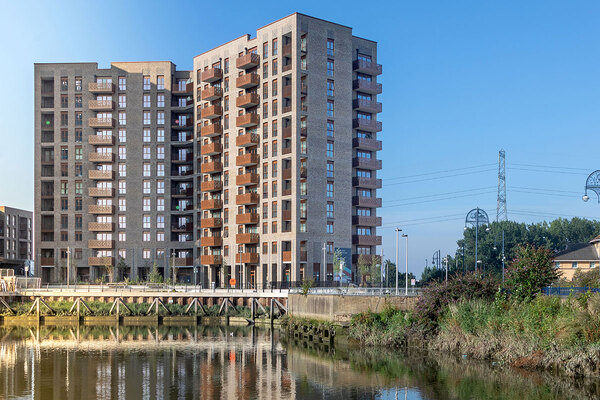You are viewing 1 of your 1 free articles
Labour’s planning plans
Jules Birch analyses this week’s flurry of housing announcements
The last day of term is traditionally a time when nothing much happens and we get set for the holidays to come.
Not so for Angela Rayner. The deputy prime minister marked the last day in parliament before the summer recess with a flurry of announcements, guidance and consultation.
Most of these – planning reforms, including a new National Planning Policy Framework (NPPF), a New Towns task force, changes to the Right to Buy – were foreshadowed in the election campaign and early days of the new government.
However, both her written statement and what she outlined to MPs included some intriguing hints of changes that go well beyond supply and planning.
And there was also an important piece of context: Ms Rayner said the government now expects to deliver just 200,000 new homes in England in this financial year. That is 100,000 fewer than the annual average needed to meet its target of 1.5 million, and will ramp up the pressure in the later years of this parliament.
Closest to home for Inside Housing readers, she outlined (what I think is) a new aspiration that the number of social rent homes should be rising rather than falling in 2025-26, the first full financial year of the parliament.
If that sounds superficially underwhelming, the net loss since 2012 is 216,000 homes. Reversing that will require action both to stem losses of existing homes and to increase development.
We already know that the government will keep the Right to Buy but review discounts (most likely to the level before they were ‘reinvigorated’ in 2012), eligibility criteria and protections for new homes. A consultation is promised in the autumn.
More immediately, new guidance on using Right to Buy receipts for replacement homes will give councils more flexibility, removing caps on the percentage that can be delivered via acquisition and allowing them to be combined with Section 106 contributions.
“Angela Rayner outlined (what I think is) a new aspiration that the number of social rent homes should be rising rather than falling in 2025-26, the first full financial year of the parliament. If that sounds superficially underwhelming, the net loss since 2012 is 216,000 homes”
Ahead of the Spending Review in October, Ms Rayner promised “details of future government investment in social and affordable housing… so that social housing providers can plan for the future and help deliver the biggest increase in affordable housing in a generation”.
Whether that optimistic tone will survive contact with a Treasury that cut investment in other areas only this week very much remains to be seen.
However, Ms Rayner also said that “the government will in the coming months publish a long-term housing strategy, alongside the Spending Review”.
That’s important (and long overdue) in its own right, but that timing should make it harder for the strategy and Spending Review to send contradictory signals.
And the deputy prime minister also promised longer-term certainty “to give councils and housing associations the rent stability they need to be able to borrow and invest in both new and existing homes”.
That’s just as well, since she also revealed that pressures on the existing Affordable Homes Programme will reduce delivery from the original target of 180,000 homes to between 110,000 and 130,000.
She promised more flexibility, especially in London, with “changes to deadlines for homes completing and tenure mix to enable some intermediate rent homes”.
On planning, a new “standard method” for identifying housing need will raise overall targets from 300,000 a year to 370,000 and require local authorities to plan for “numbers of homes that are proportionate to the size of existing communities”.
The “urban uplift” that dramatically increased the target for London has been removed, but the capital will still be expected to deliver substantially more new homes (80,000 a year) than are in its local plan (52,000) or currently being delivered (35,000).
The pressure will be on the two-thirds of local authorities that looked to evade their responsibilities by failing to draw up a local plan. That will be backed up by new Spatial Development Strategies to boost cross-boundary strategic planning.
As expected, the changes to the NPPF reverse those made in the previous version to appease rebel Tory MPs: housing-need numbers are again mandatory rather than advisory and the “out of character” density get-out clause for the suburbs has gone.
Similarly, local planning authorities should aim to meet “an area’s identified planning need” rather than as much of it “as possible”.
Criteria for using green-belt land for homes have been softened. Exceptional circumstances now explicitly include where “an authority cannot meet its identified need for housing”.
“As expected, the changes to the NPPF reverse those made in the previous version to appease rebel Tory MPs: housing-need numbers are again mandatory rather than advisory and the ‘out of character’ density get-out clause for the suburbs has gone”
First consideration should go to previously developed land and the new category of ‘grey belt’ (land that makes a limited contribution to the aims of the green belt).
Development in the green belt “should not be regarded as inappropriate” where the local planning authority has met less than 75% of its housing requirement or where it cannot demonstrate a five-year land supply.
However, where green-belt development does happen, schemes will have to include at least 50% affordable housing.
On tenure, there is an explicit reference to “the minimum proportion of social rent homes required” within what was previously a more generic statement about affordable housing.
References to Conservative policies on starter homes and a minimum proportion of affordable home ownership have been removed, while the previous housing secretary, Michael Gove’s, obsession with “beauty” has been edited out.
That said, recent changes on upward extensions of existing homes have been retained and restrictions on matching the prevailing height of the street have been eased.
New Towns are a longer-term project. “Spades in the ground” were promised by the end of the parliament, but a New Towns task force charged with identifying locations within 12 months was launched this week.
Sir Michael Lyons and Dame Kate Barker will be the chair and deputy chair. As veterans of, respectively, the Housing Commission established by former Labour leader Ed Miliband in 2014 and the independent review of housing supply commissioned by Gordon Brown in 2004, they will be well aware of the gap that can all too often develop between recommendations and policy.
Large-scale communities of “at least 10,000 new homes each, with many significantly larger” are promised to deliver “hundreds of thousands of much-needed affordable and high-quality homes in the decades to come”.
The mix will include “large-scale new communities that are separate from existing communities” – like the post-war New Towns – but “a far larger number of New Towns will be urban extensions and regeneration schemes that will work with the grain of development in any given area”.
All will target “rates of 40% affordable housing, with a focus on genuinely affordable social rented homes”.
This is a package of measures that went much further than what had been billed in advance as a statement about planning.
Some were expected, others badly needed and most are welcome, but they leave enough unanswered questions to inject a note of scepticism.
Most fundamentally, do the assumptions that the way to fix housing is to fix supply, and the way to fix supply is to fix planning, really stack up? We are about to find out.
How will the government resolve some of the implicit contradictions in its policies? More social rent is great, but it needs more grant, so what if it means fewer affordable homes overall? Is enough being done to tackle the cost pressures faced by social landlords for their existing homes?
Will a commitment to more affordable homes survive inevitable lobbying from house builders that more planning requirements will mean fewer homes for sale?
However, this week’s flurry of end-of-term announcements shows a government determined to pull as many policy levers as possible and not to let the summer holidays get in the way.
Jules Birch, columnist, Inside Housing
Sign up for our development and finance newsletter
Already have an account? Click here to manage your newsletters













